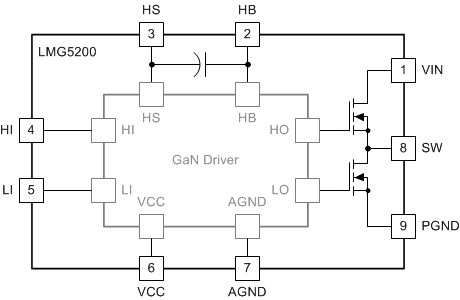ZHCSFT3D March 2015 – March 2017 LMG5200
PRODUCTION DATA.
1 特性
2 应用
- 宽 VIN 数兆赫兹同步降压转换器
- D 类音频放大器
- 适用于电信、工业和企业计算的 48V 负载点 (POL) 转换器
- 高功率密度单相和三相电机驱动
3 说明
LMG5200 器件集成了 80V、10A 驱动器和 GaN 半桥功率级,采用增强模式氮化镓 (GaN) FET 提供了一套集成功率级解决方案。该器件包含两个 80V GaN FET,它们由采用半桥配置的同一高频 GaN FET 驱动器提供驱动。
GaN FET 在功率转换方面的优势显著,因为其反向恢复电荷几乎为零,输入电容 CISS 也非常小。所有器件均安装在一个完全无键合线的封装平台上,尽可能减少了封装寄生元件数。LMG5200 器件采用 6mm × 8mm × 2mm 无铅封装,可轻松安装在 PCB 上。
该器件的输入与 TTL 逻辑兼容,无论 VCC 电压如何,都能够承受高达 12V 的输入电压。专有的自举电压钳位技术确保了增强模式 GaN FET 的栅极电压处于安全的工作范围内。
该器件配有用户友好型接口且更为出色,进一步提升了分立式 GaN FET 的优势。对于具有高频、高效操作及小尺寸要求的 应用 而言,该器件堪称理想的解决方案。与 TPS53632G 控制器搭配使用时,LMG5200 能够直接将 48V 电压转换为负载点电压 (0.5-1.5V)。
器件信息(1)
| 器件型号 | 封装 | 封装尺寸(标称值) |
|---|---|---|
| LMG5200 | QFM (9) | 6.00mm × 8.00mm |
简化框图
